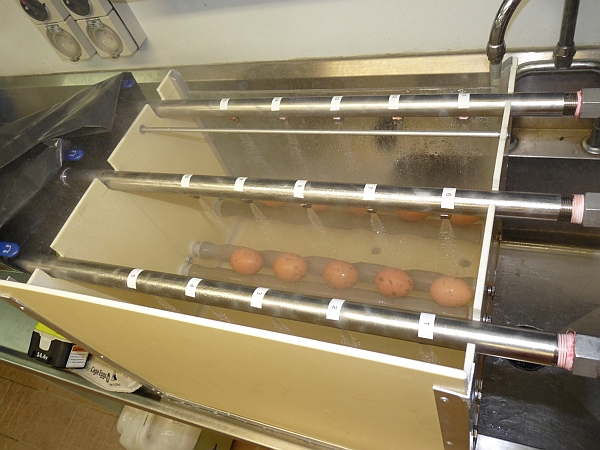The first two projects completed under the second round Poultry CRC have now been joined by a third. Dr Margaret Sexton’s To improve the efficacy and safety of egg washing has just reached completion. The aims of this project were to improve the recovery of dirty and so-called ‘black eggs’ and to reduce microbial contamination on egg shells. These aims were achieved through a series of laboratory and in-plant trials.
In the first laboratory trial, two suitable detergent/sanitiser and wash/sanitise temperature combinations were identified, based on their ability to clean artificially dirtied eggs. These combinations were found to be effective for the recovery of black eggs and reduced Salmonella from inoculated egg shells.
During in-plant trials at three commercial egg washing businesses, multiple washings with either of the chemical combinations resulted in up to 85% recovery of black eggs after four washes. The efficacy varied between plants and was affected by plant specific issues such as ability to accurately dose chemicals, blocked spray jets, brushes interfering with sprays, ability to measure and maintain the water temperature at the egg surface and the recycling of water.
Cleaning and sanitising of washing/grading equipment is often difficult and overlooked as a potential source of contamination. Perhaps not surprisingly, the project detected microbes of faecal origin from grading machinery, indicating the potential for re-contamination of eggs following washing. Stringent plant hygiene protocols can assist in reducing this risk and subsequent potential for foodborne illness. Food Standards Australia New Zealand estimates that egg-related salmonellosis cases cost the Australian economy $44 million per annum.
In 2009/2010, the annual Australian production of eggs totalled 345 million dozen (AECL, 2009)*. The majority of eggs are washed prior to packing to remove dirt and faecal material, and to reduce the microbial contamination of the egg shell. An estimated 2% of non-cage eggs are ‘black eggs’ and these are currently discarded because they are considered unrecoverable.
Based on the above 2009 production volumes and findings from this work, 2.14 million dozen black eggs could potentially be recovered, totalling a retail value of $9.48M. These figures are expected to increase as barn-laid, free range and organic egg production systems gain market share.
While the benefits of washing eggs continue to be debated, this work clearly demonstrates that washing can remove faecal and microbiological contamination from the egg surface. Reducing the microbial load on egg shells will help make eggs safer for the consumer and reduce the potential for foodborne outbreaks.
*(Ed. – in 2010/2011 this figure was raised to 357 million dozen)



